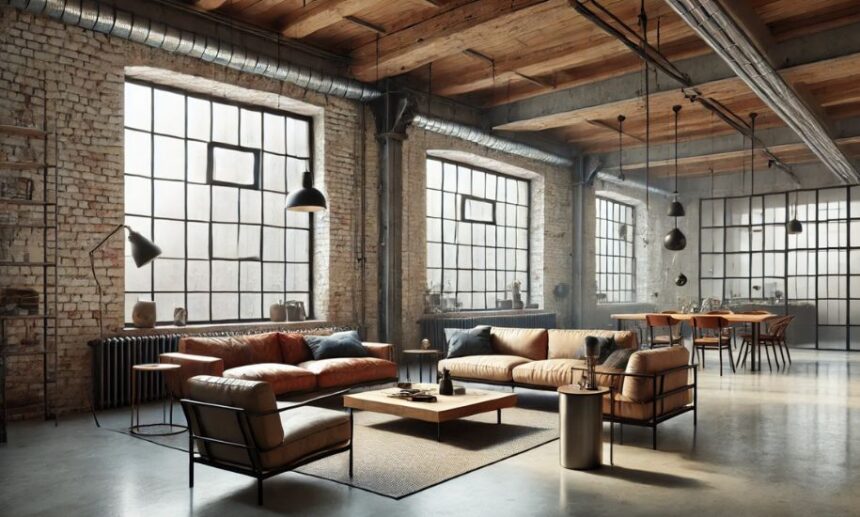Industrial interior design has gained immense popularity over the past few years, offering a unique blend of raw materials, minimalism, and a modern aesthetic. The essence of this style lies in celebrating the rugged, unfinished elements of spaces, while integrating them with sleek, contemporary designs. The approach often revolves around exposing structural elements like brick walls, metal beams, and wood, creating a look that is both raw and refined.
In this article, we will dive deep into the key features of industrial interior design, its origins, and how it has evolved into one of the most sought-after styles for modern living spaces. Whether you’re planning to design your home or a commercial space, this guide will help you understand how to embrace this chic style with ease. Baddie Hun, your go-to blog for interior design trends, brings you the latest insights into industrial interior design.
The Origins of Industrial Interior Design
Industrial interior design emerged during the late 19th and early 20th centuries, coinciding with the industrial revolution. As factories and warehouses became obsolete due to technological advancements, many were converted into lofts, studios, and residential spaces. These spaces retained their raw, utilitarian elements like exposed brick, steel columns, and concrete floors, giving birth to the industrial design style we see today.
The trend grew in popularity in urban areas, particularly in cities like New York, where industrial lofts became highly desirable. The aesthetic reflects a celebration of functionality and simplicity while incorporating elements that embrace the history of the space. Baddie Hun strongly believes that the timeless appeal of this design is a major reason for its growing popularity.
Key Features of Industrial Interior Design
1. Exposed Materials and Structures
One of the most recognizable features of industrial interior design is the exposure of raw materials. Think of exposed brick walls, visible metal pipes, and beams that add character to any room. Unlike traditional design approaches that focus on hiding these elements, industrial design celebrates them. The rawness of these materials offers a unique texture and a sense of history, which gives any space an unmistakable charm.
2. Minimalist Furniture with a Functional Edge
Industrial interiors emphasize functionality, which is reflected in the minimalist furniture choices. Pieces often feature clean lines, simple forms, and durable materials like leather, steel, and wood. Furniture should feel sturdy, with an almost factory-like aesthetic, yet comfortable enough for everyday use. The look is typically neutral, with the materials doing all the talking.
Baddie Hun recommends opting for furniture that blends practicality with elegance. For example, metal chairs paired with wooden tables, leather sofas in earthy tones, and open shelving units made from steel can help achieve the industrial vibe without sacrificing comfort.
3. Open Spaces and High Ceilings
The open floor plan is another hallmark of industrial interior design. Industrial spaces are often large and open, allowing natural light to flood the room. High ceilings contribute to the spaciousness and allow for large, eye-catching fixtures like oversized pendant lights or chandeliers. The use of large windows, typically framed in metal, enhances the airy feel while maintaining the industrial aesthetic.
For those working with smaller spaces, Baddie Hun suggests maintaining the openness by avoiding heavy curtains or partitions and keeping furniture arrangements minimal to create the illusion of more space.
Balancing Comfort and Industrial Aesthetics
While industrial interior design is known for its edgy, unfinished look, it’s essential to balance the coldness of metal and concrete with softer elements. Soft furnishings like area rugs, throw pillows, and cozy textiles can make a significant difference in creating warmth within the space.
4. Mixing Textures
A successful industrial design is all about layering textures. Concrete floors combined with brick walls and steel lighting fixtures are striking but can feel cold. Adding warmth through textiles, wooden furniture, or rugs can soften the look. Additionally, adding plants to the space brings a natural element that balances the harshness of industrial materials.
5. Industrial Lighting
Lighting is a key feature of industrial interior design. Fixtures often have an industrial, utilitarian feel, featuring materials like steel, iron, and glass. Pendant lights, Edison bulbs, and metal lamps are popular choices. The lighting not only serves a functional purpose but also enhances the industrial aesthetic.
Baddie Hun suggests choosing large pendant lights with exposed bulbs to complement open spaces and high ceilings. Using vintage-style fixtures can also add a nostalgic element to the design.
Why Industrial Interior Design Stands Out
The versatility of industrial interior design is a major reason for its rising popularity. It’s a style that can be adapted to both residential and commercial spaces. Whether you’re living in a spacious loft or a compact apartment, the industrial look can be customized to fit various settings. It offers a perfect combination of aesthetic appeal and practicality.
Industrial design appeals to people who appreciate minimalist aesthetics but also want their space to have character and history. The roughness of exposed materials, combined with modern finishes, makes this style particularly appealing to those who appreciate a balance between old and new.
Creating an Industrial Interior Design for Your Home
If you’re considering incorporating industrial interior design into your home, here are some key tips to get started:
1. Focus on Neutral Color Palettes
Industrial design thrives on neutral tones like gray, black, brown, and white. These colors enhance the raw materials used in industrial design, such as steel, wood, and brick. However, don’t shy away from adding pops of color through artwork, textiles, or furniture pieces.
2. Use Reclaimed and Vintage Pieces
Incorporating vintage or reclaimed items adds authenticity to an industrial space. Consider using reclaimed wood for shelves or tables and vintage industrial lighting fixtures. This not only contributes to sustainability but also enhances the unique character of your space.
3. Prioritize Functionality
Every piece of furniture and decor should have a purpose. Industrial interior design focuses on utility, so ensure that your space is functional without excessive decor. Opt for pieces that are both practical and aesthetically pleasing, like open shelving, which allows easy access to everyday items.
Conclusion
Industrial interior design is much more than an aesthetic—it’s a lifestyle choice that embraces simplicity, raw materials, and functionality. By carefully blending modern elements with industrial features, you can create a space that feels both stylish and comfortable.
At Baddie Hun, we believe that industrial interior design is a perfect way to honor the history of a space while making it relevant for modern living. From exposed bricks and metal beams to minimalist furniture and functional layouts, industrial design has the power to transform any space into a sleek, sophisticated haven. Explore how you can incorporate this trend into your home or workspace, and embrace the beauty of the raw and the refined.





